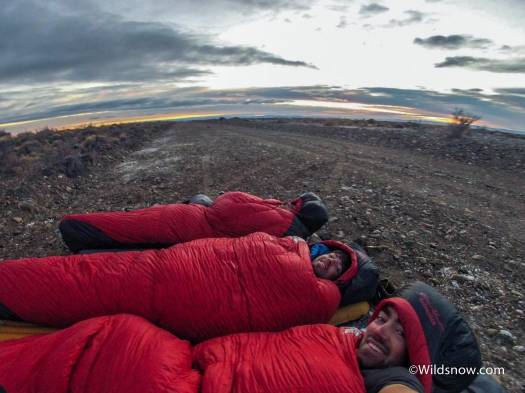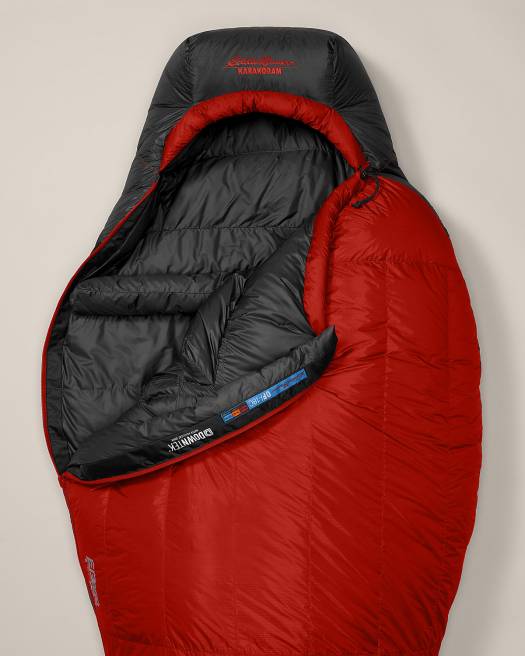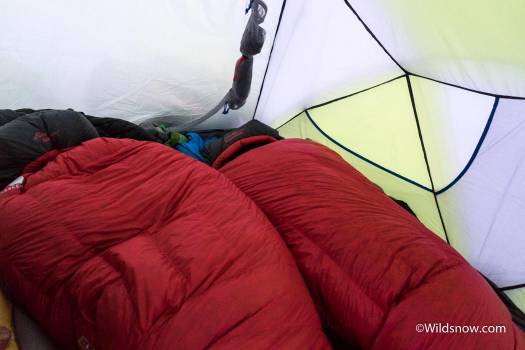Choosing a sleeping bag for my South America trip was difficult. I knew I’d be spending a lot of time in the bag, in both warm and potentially very cold conditions. Not only that, weight is a big concern, not only for carrying, but also in the battle to get your gear under the airline weight limits.
I’ve always been a fan of synthetic insulation, but when it comes to sleeping bags the lightweight qualities of down are usually enough to convince me to go with a feather-filled sack. In recent years the introduction of “water resistant” down technology has made me even more inclined to choose a down bag. Thus, I’ve been wanting to try out water resistant down. This trip was the opportunity.
First Ascent Karakoram StormDown Sleeping Bag series features DownTek insulation, one of the many DWR treated down insulations that have come on the scene in recent years. The Karakoram 0 that I tested has 850+ fill DownTek, and weighs in at about 2 lbs 12 oz, with a fill weight of 1 lb 11.6 oz. The other features of the bag are pretty standard with a focus on it being lightweight. It has thin DWR Pertex fabric on the exterior, with softer, non DWR fabric inside. Inside, the bag has a draft collar (although with no drawstring), and a big zippered pocket.
Skyler, Cooper and I each tested one of the Karakoram sleeping bags on the trip. We got the bags only a few days before hopping on the plane to Santiago, so no chance to test them out (and balmy August temps in Washington wouldn’t allow that). Over the course of the trip, we used the bags extensively and they worked well.
The major advantage of the bag is it’s minimal weight; 2 lbs 12 oz is just about as light as you can get for a 0 degree bag. This is of course a function of the lightweight materials, and high-fill down that is used. When dry down was first introduced many of the products that utilized it were only available with 600 fill down, which can add significantly to the weight of a bag. The Karakoram has 850+ down.
For the first part of our trip we had either good conditions, or were sleeping in the tent, so I didn’t get much opportunity to test the water-resistant properties of the bags.
When we first arrived in the Chalten area of Patagonia, our first objective was Cerro Electrico, a (relatively) small peak that boasts great skiing and incredible views of Fitz Roy. The evening before, we drove to the trailhead, and rolled out our sleeping bags on the edge of the nearby river. Not motivated to set up our tent, we instead opted to sleep out. Early the next morning we woke to the inside of a thick fog bank, no doubt fed by the cold river right next to us. Normally this would be a problem with a down bag, but we were pleasantly surprised to wake up in warm, mostly-dry and still lofted bags.
A few weeks later, in the Torres Del Paine national park, we faced a dilemma. The only thing we knew was the that the hike was going to be long — possibly really long — with no guarantee of skiing at the end. In an effort to eliminate weight from our packs we ditched the tent, and only brought our bags and pads. The next day we camped out high in the mountains, directly under Torres Del Paine. The dry-down bags were ideal for the situation, since they had the potential of keeping us warm in the unlikely event of a rain or snow storm, allowing us to abandon the weight (and safety) of a tent.
Because the bag is a lightweight, it is lacking in the durability department. The fabric is minimalist, and I’ve noticed a bit of piling and wear, particularly on the hood and the interior near the feet (likely exacerbated by storing stuff at the foot of the bag when I’m sleeping). That’s just about the only negative aspect of the Karakoram that I’ve been able to find.
The Karakoram incorporates some well thought out features, chief of which is the StormDown. Also, the interior pocket is big, and it easily fits things like glasses, ear plugs, and a headlamp. The cut of a sleeping bag is important to me, since I’m skinny, and a sleeping bag that is cut too big is not only wasted material, but is harder to keep warm than one that is cut tight. On the other hand, one that is too skinny doesn’t have the room necessary to wear clothes or store things like gloves and boot liners to dry out. The Karakoram seems to have a fairly standard cut, perhaps on the skinnier side, which worked perfectly for us.
Shop for sleeping bags at Backcountry.com.
Louie Dawson earned his Bachelor Degree in Industrial Design from Western Washington University in 2014. When he’s not skiing Mount Baker or somewhere equally as snowy, he’s thinking about new products to make ski mountaineering more fun and safe.



